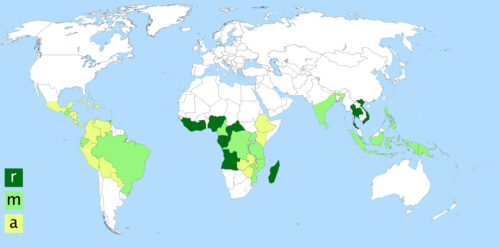Silencio Calm Chaos Medium Roast Coffee.
National Coffee Day is observed on September 29th in many countries, including the United States, Canada, and Australia. For many of us though, every day is National Coffee Day.
Coffee is one of the most popular and beloved beverages in the world, but where does it come from? Its origin can be traced back to the beautiful country of Ethiopia, around 800 AD. According to legend, the discovery of coffee began with a curious goat herder named Kaldi. One day, Kaldi noticed his goats acting unusually energetic and spirited. He observed them nibbling on bright red berries from a certain tree. Intrigued, he decided to try some of the berries himself and felt a surge of vitality. He then brought some of the berries to a local monastery, where a monk brewed them into a drink. The monk was amazed by the drink’s ability to keep him awake during long hours of prayer. Thus, the word of coffee spread throughout the region and beyond.

From there, coffee traveled to Europe, where it was initially met with suspicion and resistance. Some people viewed it as a threat to their religious beliefs or their health. However, coffee gradually gained acceptance and popularity, especially after Pope Clement VIII declared it harmless and delicious in 1615. Coffee houses became centers of commerce, culture, and politics in major European cities. Coffee also stimulated the scientific and artistic movements of the Enlightenment and the Romantic era.
Coffee’s journey continued to the New World, where it was introduced by European colonists and explorers. In 1720, coffee plants were brought to Martinique by Gabriel de Clieu, a French naval officer. These plants later sprouted thousands of coffee trees that enabled its spread to other Caribbean islands, Central America, and South America by French, Dutch, Spanish, and Portuguese traders. Brazil soon emerged as the world’s largest producer of coffee, followed by Colombia, Vietnam, and Indonesia. Coffee also played a role in the American Revolution and the Civil War, as it boosted the morale and energy of the soldiers.

There are over 120 species and sub-species of coffee plants, but the most commercially important ones belong to two main types: Coffea arabica and Coffea canephora. Coffea arabica, also known as Arabian coffee, is native to Ethiopia and Sudan, and produces the highest quality beans with a rich and complex flavor. It usually grows in the shade of other trees and requires a cool and moist climate. Coffea canephora, also known as robusta coffee, is native to western Africa, and produces lower quality beans with a bitter and harsh taste. It is more tolerant of sun, heat, and pests, and has a higher caffeine content than arabica. It is often used in instant coffee or blended with arabica to lower the cost.
Before being roasted and brewed into the drink we know today, coffee beans go through a series of steps to bring out their best qualities. The first step is processing, which involves removing the pulp from the coffee cherries after harvesting. There are two main methods of processing: the dry method and the wet method. The dry method is the oldest and simplest way of processing coffee, where the cherries are spread out on large surfaces to dry in the sun for several weeks until they reach a moisture content of 11%. The wet method is more complex and requires more water and equipment. It involves removing the pulp from the cherries by using a machine called a pulper, then fermenting and washing the beans in water tanks to remove any remaining mucilage. The beans are then dried either by sun or by machine until they reach a moisture content of 10-12%.

The next step is roasting, which transforms the chemical and physical properties of the green coffee beans into roasted coffee products. The roasting process is what produces the characteristic flavor and aroma of coffee by causing various chemical reactions such as caramelization (the browning of sugars), Maillard reaction (the reaction between sugars and amino acids), pyrolysis (the decomposition of organic matter by heat), and Strecker degradation (the breakdown of amino acids into aldehydes). These reactions create hundreds of volatile compounds that contribute to the sensory qualities of coffee.

The Maillard reaction is one of the most important reactions for flavor development in coffee roasting. It begins at around 150°C/302°F when heat causes a reaction between carbohydrates (sugars) and amino acids (proteins) in the beans. This results in changes in color (from yellow to brown), flavor (from sweet to bitter, nutty, or caramel-like), and nutritional content (reducing the amount of amino acids and vitamins). The Maillard reaction also depends on other factors such as the pH, the amount of water, and the type and concentration of sugars and amino acids. Different combinations of these factors can produce different flavor profiles in coffee.
Pyrolysis is another important reaction for flavor development in coffee roasting. It occurs when organic matter is heated above its decomposition temperature, producing volatile compounds and leaving behind a solid residue containing a lot of carbon (char). Pyrolysis is responsible for creating some of the roasted, smoky, and burnt flavors in coffee. It also affects the color and body of coffee by producing melanoidins, which are large molecules that give coffee its brown color and viscosity. Pyrolysis can also degrade some of the acids that produce fruity and sweet notes in coffee, reducing its acidity and complexity.
Strecker degradation is a reaction that depends on the Maillard reaction. It occurs when amino acids react with carbonyl-grouped molecules (such as sugars or aldehydes) to create compounds such as aldehydes and ketones. These compounds are essential for the creation of aroma- and flavor-producing compounds in coffee. For example, methional is an aldehyde that is formed from the Strecker degradation of methionine, an amino acid. Methional has a cooked potato-like aroma and contributes to the savory notes in coffee.

The final step is grinding, which prepares the roasted coffee beans for brewing. Grinding reduces the size of the beans to increase their surface area and expose their flavor compounds to water extraction. The fineness or coarseness of the grind depends on the brewing method used. Generally speaking, finer grinds are used for espresso machines or moka pots that use high pressure and short extraction time; coarser grinds are used for drip coffee makers or French presses that use low pressure and long extraction time.
*The views and opinions expressed on this website are solely those of the original authors and contributors. These views and opinions do not necessarily represent those of Spotter Up Magazine, the administrative staff, and/or any/all contributors to this site.

